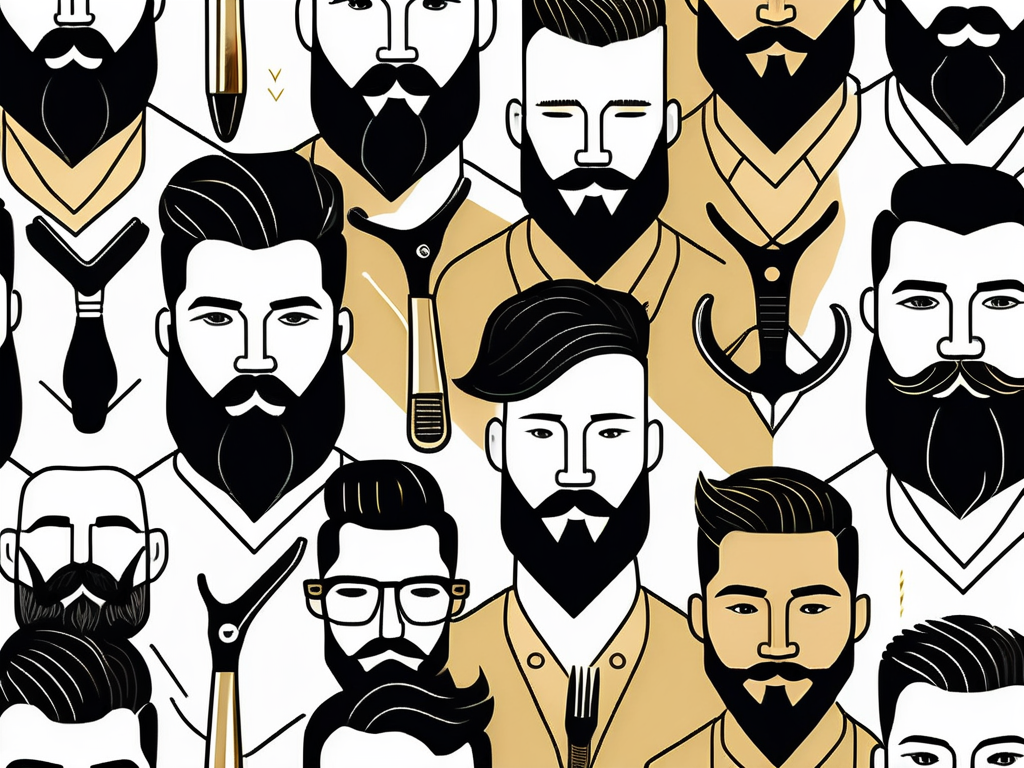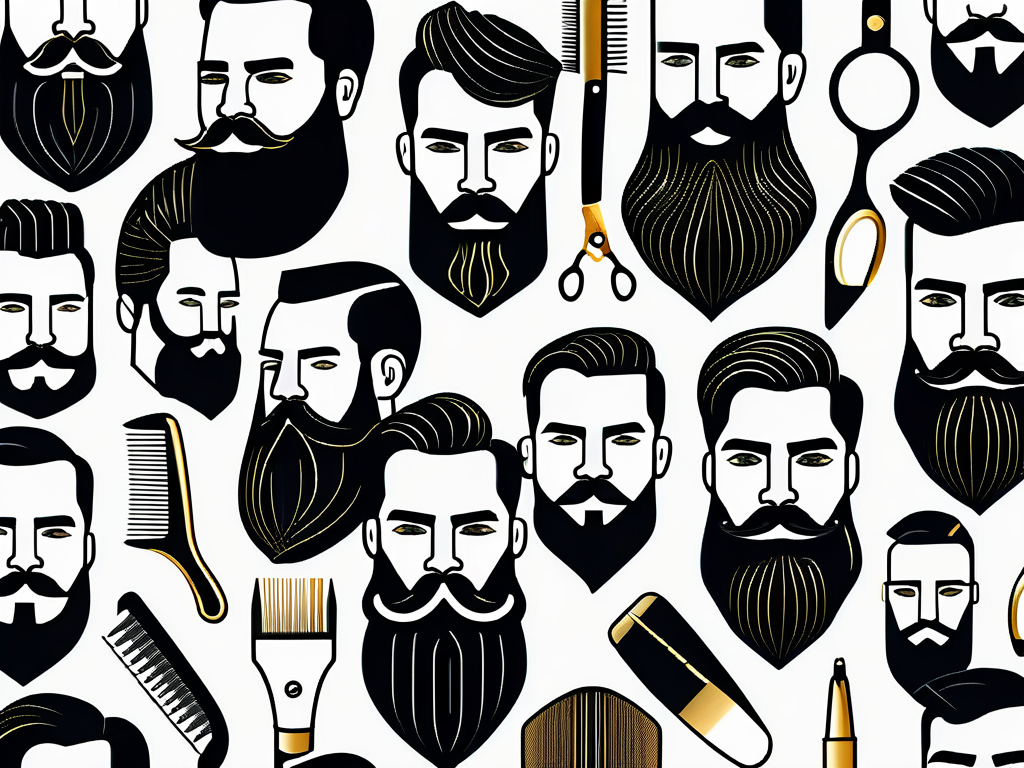Author: The Beard Struggle
Published at: Sep 13, 2024
Growing a beard is an art, but maintaining it? That’s a science. If you've ever found yourself wondering "How frequently should you trim your beard?" you're not alone.
The answer isn't one-size-fits-all but rather depends on factors like beard length, style, and even how fast your hair grows.
Interestingly, facial hair grows about half an inch per month, which means even a few days without trimming can turn a neat beard into a wild mane.
In this article, we'll:
Let's dive into the details and discover the perfect trimming routine for your beard
Achieving a well-groomed beard isn’t just about letting it grow; it’s about knowing when and how often to trim it to keep it looking sharp, healthy, and stylish.
Whether you're rocking a short, medium, or long beard, each style requires a different trimming frequency to maintain its shape and overall appeal. Let’s break it down so you can easily master your beard maintenance routine.
Short beards demand regular attention to stay neat and defined. If your beard is short, aim to trim it every week or at least every two weeks.
This frequent trimming helps maintain the clean edges that are characteristic of short beards, preventing any stray hairs from disrupting the sharp, well-groomed appearance. Plus, keeping a consistent trimming schedule ensures that your beard remains uniform in length, which is key to avoiding any patchy or uneven spots.
A short beard that isn’t regularly trimmed can quickly lose its shape, leading to a scruffy or unkempt look. Weekly or bi-weekly trimming keeps your beard looking intentional and polished, which is especially important if you’re aiming for a professional or refined style.
If your beard falls into the medium-length category, trimming every 2 to 4 weeks is ideal. This timeline strikes a balance between maintaining the beard’s shape and allowing it to grow out just enough to showcase its natural fullness.
During these trims, focus on maintaining the beard’s overall shape, cleaning up the neckline, and trimming any uneven areas to ensure consistent, even growth.
Medium-length beards have the potential to look both rugged and refined, but only if they’re properly maintained. Trimming every few weeks helps you achieve that balance, giving your beard a full, healthy appearance without letting it become unruly.
For those sporting a long beard, patience is key, but so is regular maintenance. Trimming every 6 to 8 weeks allows you to maintain the beard’s length while ensuring it remains healthy and well-shaped.
During these less frequent trims, focus on removing split ends and shaping the beard to prevent it from looking wild or unkempt. Long beards also benefit from the occasional trim to avoid thinning ends, which can make the beard appear less full.
A long beard can be a statement of style, but without proper care, it can easily veer into the territory of looking untamed. By trimming every couple of months, you can maintain the length and volume while ensuring your beard looks deliberate and stylish, rather than overgrown.
Understanding the factors that influence how often you should trim your beard is crucial for maintaining a well-groomed appearance.
Let's explore four key elements that play a significant role in determining your ideal beard-trimming schedule.

Your beard's growth rate is a primary factor in determining trimming frequency.
Your preferred beard style and length significantly impact your trimming schedule.
Your natural features play a role in determining your ideal beard style and, consequently, your trimming needs.
Your daily life and work environment can influence your beard maintenance needs.
Determining your ideal beard-trimming frequency is a personal process that depends on these four key factors. By considering your growth rate, desired style, facial features, and lifestyle, you can develop a customized trimming schedule that keeps your beard looking its best while fitting seamlessly into your daily routine.
Remember, the perfect beard trimming routine is one that you can consistently maintain and that makes you feel confident in your appearance.
Achieving the perfect beard trim isn’t just about having the right tools—it’s about knowing how to use them effectively and understanding when it’s best to take matters into your own hands or seek professional help.
Whether you’re a seasoned beard enthusiast or just starting your grooming journey, mastering the right tools and techniques will ensure your beard always looks sharp, stylish, and well-maintained.
Let’s explore the essentials of beard trimming to help you achieve the perfect look every time.

To trim your beard effectively, you need the right tools in your grooming arsenal. Each tool serves a specific purpose, and knowing when and how to use them can make all the difference in achieving a precise, clean trim.
Clippers: Clippers are your go-to tool for maintaining an even beard length. They come with adjustable guards that allow you to trim your beard to a uniform length, whether you’re going for a close-cropped look or a longer, fuller beard. Clippers are particularly useful for those with thick or dense beards, as they can quickly and efficiently cut through more hair.
Scissors: Scissors are essential for detailed trimming work. They allow you to snip away stray hairs, shape the edges of your beard, and clean up areas that require precision, such as around the mouth or along the neckline. High-quality beard scissors are key to avoiding jagged cuts and ensuring a smooth, clean finish.
Combs: A good wooden comb for beard is indispensable for detangling your beard and ensuring an even trim. By combing through your beard before trimming, you can identify any uneven areas and make sure the hair is aligned for a consistent cut. Combs also help in distributing beard oil or balm evenly, keeping your beard soft and manageable.
Trimmers: Beard trimmers are versatile tools that can handle both detailed work and overall beard maintenance. They’re perfect for defining lines, such as your neckline or cheekline, and for trimming areas that require a delicate touch. Trimmers often come with various attachments for different lengths and detailing work, making them a must-have for any beard enthusiast.
Trimming your beard at home can be a straightforward process if you follow the right techniques. Here’s a step-by-step guide to help you achieve a professional-quality trim in the comfort of your own home:
Start with a Clean, Dry Beard: Before you begin trimming, make sure your beard is clean and dry. Washing your beard removes any dirt, oil, or product build up, while drying it ensures you get an accurate cut.
Comb Your Beard: Use a comb to detangle your beard and align the hairs in one direction. This will help you identify any uneven areas and make the trimming process smoother.
Choose Your Desired Length: If you’re using clippers, select the appropriate guard length for the style you want. Start with a longer guard to avoid cutting too much hair, and then gradually switch to shorter guards if needed.
Trim Evenly: Begin trimming your beard using clippers or a trimmer, starting from the sides and working your way down. Move the clippers or trimmer in the direction of hair growth to avoid irritation and achieve an even cut.
Shape the Edges: Use scissors or a precision trimmer to shape the edges of your beard, including the neckline, cheekline, and mustache area. Take your time with this step to ensure clean, sharp lines that enhance your beard’s overall shape.
Check for Symmetry: After trimming, check your beard in the mirror to ensure both sides are symmetrical. Make any necessary adjustments with scissors or a trimmer.
Finish with a Comb and Oil: After trimming, comb through your beard one more time to remove any loose hairs. Apply beard oil or balm to keep your beard soft, hydrated, and looking its best.
While trimming your beard at home is convenient and cost-effective, there are times when it’s best to seek the expertise of a professional barber. Understanding when to visit a barber versus when to trim at home can make a significant difference in the outcome of your beard grooming.
When to Trim at Home: If you’re maintaining a simple style or just need a quick touch-up, trimming at home is usually sufficient. With the right tools and techniques, you can easily keep your beard looking neat and well-groomed between professional visits.
When to Visit a Barber: If you’re going for a more complex style, such as a fade or a highly detailed beard shape, a professional barber’s expertise is invaluable. Barbers have the experience and tools to achieve precise, tailored cuts that can be difficult to replicate at home. Additionally, if you’re unsure about your beard’s overall shape or need advice on the best style for your face, a barber can provide personalized guidance.
By mastering the essential tools and techniques for beard trimming, you can take full control of your grooming routine and keep your beard looking its best at all times.
Whether you choose to trim at home or visit a professional barber, understanding these fundamentals ensures that your beard is always sharp, stylish, and a true reflection of your personal style.
Achieving a consistent and polished beard style requires more than just occasional trimming—it's about establishing a routine that suits your specific beard type.
Start by selecting quality grooming tools and setting a schedule that works for you. Pay attention to the finer details, like the direction of your trim and keeping your tools clean, to avoid common pitfalls. With dedication and the right approach, you can take control of your beard and enjoy a well-groomed look every day.
Elevate your grooming routine with premium tools and expert advice from The Beard Struggle and achieve the beard of your dreams.

10 Beard Care Mistakes A Viking Should Never Make
Register now to receive 10 exclusive tips straight to your inbox.
Comments
Hello! Shopping from United States?
Shipping destination